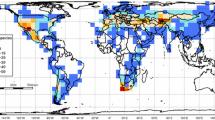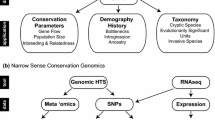Abstract
Bees are major pollinators of Angiosperms and therefore their apparent decline is of importance for humans and biodiversity. We synthesise results of 12 recent reviews to provide a global picture of the threats they face. Habitat loss is the major threat to bee diversity, whilst invasive species, emerging diseases, pesticide use, and climate change also have the potential to impact bee populations. We suggest that future conservation strategies need to prioritise (i) minimising habitat loss, (ii) making agricultural habitats bee-friendly, (iii) training scientists and the public in bee taxonomy and identification, (iv) basic autecological and population genetic studies to underpin conservation strategies, (v) assessing the value of DNA barcoding for bee conservation, (vi) determining the impact of invasive plants, animals, parasites and pathogens, and (vii) integrating this information to understand the potential impact of climate change on current bee diversity.
Zusammenfassung
Bienen sind die wichtigsten Bestäuber von wildblühenden und landwirtschaftlichen Nutzpflanzen. Das hat zur Konsequenz, dass ihre offensichtliche Abnahme eine bedeutende Sorge um die Ernährung der Menschen und die Erhaltung der Biodiversität im großen Maßstab darstellen sollte. Hier stellen wir die Ergebnisse von 12 neuesten Übersichtsartikeln zusammen, um ein globales Bild der Abnahme der Bienen und von den Bedrohungen, denen die Bienen ausgesetzt sind zu erhalten (Tab. I). Ganz offensichtlich stellt der Verlust an Lebensräumen die hauptsächliche Bedrohung der Vielfalt der Bienen wie der Biodiversität im Allgemeinen dar. Es können aber auch andere Faktoren wie invasive Arten, das Auftauchen neuer Krankheiten, die Verwendung von Pestiziden und der Klimawandel zu bedeutenden Belastungen für die Bienenpopulationen werden. Obwohl es sehr schwierig ist, den Beitrag aller dieser Faktoren zu trennen, ist dies aber eine unabdingbare Aufgabe wenn wir die Bienendiversität erhalten, unterstützen oder wiederherstellen wollen. Es ist offensichtlich, dass die derzeitigen Erhaltungsanstrengungen durch den Mangel an grundlegenden Daten zur Verteilung, Häufigkeit, Ökologie und Populationsgenetik behindert werden. Wir schlagen vor, dass zukünftige Erhaltungsstrategien hauptsächlich auf folgende Punkte ausgerichtet werden sollten: (i) die Minimierung des Verlustes an Lebensraum, (ii) die bienenfreundliche Gestaltung landwirtschaftlicher Habitate, (iii) die Unterweisung von Wissenschaftlern und der Öffentlichkeit in Bienentaxonomie und der Bestimmung der Arten, (iv) der Erstellung von grundlegenden autökologische und populationsgenetische Studien zur Untermauerung der Erhaltungsmassnahmen, (v) der Ermittlung der Nutzbarkeit von DNA Barcoding für die Bienenerhaltung, (vi) der Bestimmung der Auswirkungen invasiver Pflanzen, Tieren, Parasiten und Pathogenen, und (vii) der Zusammenführung dieser Information, um die möglichen Auswirkungen des Klimawechsels auf die verbleibende Bienendiversität verstehen zu können. Zusätzlich zu diesen Prioritäten sollte das vielfältige Angebot an internationalen, nationalen und regionalen Ansätzen und politischen Maßnahmen für die Bienenerhaltung zusammengeführt werden, um Überschneidungen aufzulösen und ein zusammenhängendes Rahmenwerk für die Erhaltungs- und Wiederherstellungsaktivitäten zu schaffen. Während Bienen aller Art über den ganzen Globus hinweg Bedrohungen gegenüberstehen, glauben wir, dass es uns mit abgestimmtem und wissenschaftlich fundiertem Handeln möglich ist die Diversität der Bienen für die zukünftigen Generationen zu erhalten oder wiederherzustellen.
Article PDF
Similar content being viewed by others
Avoid common mistakes on your manuscript.
References
Abbott A. (2009) European disarray on transgenic crops, Nature 457, 946–947.
Aizen M.A., Garibaldi L.A., Cunningham S.A., Klein A.M. (2008) Long-term global trends in crop yield and production reveal no current pollination shortage but increased pollinator dependency, Curr. Biol. 18, 1572–1575.
Andrewartha H.G., Birch L.C. (1954) The distribution and abundance of animals, The University of Chicago Press, Chicago, Illinois
Batley M., Hogendoorn K. (2009) Diversity and conservation status of native Australian bees, Apidologie 40, 347–354.
Biesmeijer J.C., Roberts S.P., Reemer M., Ohlemueller R., Edwards M., Peeters T., Schaffers A., Potts S.G., Kleukers R., Thomas C.D., Settele J., Kunin W.E. (2006) Parallel declines in pollinators and insect-pollinated plants in Britain and the Netherlands, Science 313, 351–354.
Brook B.W., Sodhi N.S., Bradshaw C.J.A. (2008) Synergies among extinction drivers under global change, Trends Ecol. Evol. 23, 453–460.
Buchmann S.L., Nabhan G.P. (1996) The forgotten pollinators, Island Press, Shearwater books, Washington DC.
Byrne A., Fitzpatrick Ú. (2009) Bee conservation policy at the global, regional and national levels, Apidologie 40, 194–210.
Co-op (2009) The Co-operative Society of the UK. [online] http://www.co-operative.coop/ ethicsinaction/takeaction/planbee (accessed on 5 March 2009).
Costanza R., d’Arge R., de Groot R., Farber S., Grasso M., Hannon B., Limburg K., Naeem S., O’Neill R.V., Paruelo J., Raskin R.G., Sutton P., van den Belt M. (1997) The value of the World’s ecosystem services and natural capital, Nature 387, 253–259.
Cox-Foster D.L., Conlan S., Holmes E.C., Palacios G., Evans J.D., Moran N.A., Quan P.-L., Briese T., Hornig M., Geiser D.M., Martinson V., van Engelsdorp D., Kalkstein A.L., Drysdale A., Hui L., Zhai J., Cui L., Hutchison S.K., Simons J.F., Egholm M., Pettis J.S., Lipkin W.I. (2007) A Metagenomic Survey of Microbes in Honey Bee Colony Collapse Disorder, Science 318, 283–287.
De La Rúa P., Jaffé R., Dall’olio R., Munoz I., Serrano J. (2009) Biodiversity, conservation and current threats to European honeybees, Apidologie 40, 263–284.
Dietemann V., Pirk C.W.W., Crewe R. (2009) Is there a need for conservation of honeybees in Africa? Apidologie 40, 285–295.
Eardley C.D., Gikungu M., Schwarz M.P. (2009) Bee conservation in Sub-Saharan Africa and Madagascar: diversity, status and threats, Apidologie 40, 355–366.
Elias M., Hill R.I., Willmott K.R., Dasmahapatra K.K., Brower A.V.Z., Mallet J., Jiggins C.D. (2007) Limited performance of DNA barcoding in a diverse community of tropical butterflies, Proc. R. Soc. London B 274, 2881–2889.
Ellis J.S., Knight M.E., Darvill B., Goulson D. (2006) Extremely low effective population sizes, genetic structuring and reduced genetic diversity in a threatened bumblebee species, Bombus sylvarum (Hymenoptera: Apidae), Mol. Ecol. 15, 4375–4386.
Fitzpatrick Ú., Murray T.E., Paxton R.J., Breen J., Cotton D., Santorum V., Brown M.J.F. (2007) Rarity and decline in bumblebees — a test of causes and correlates in the Irish fauna, Biol. Conserv. 136, 185–194.
Foley J.A., DeFries R., Asner G.P., Barford C., Bonan G., Carpenter S.R., Chapin F.S., Coe M.T., Daily G.C., Gibbs H.K., Helkowski J.H., Holloway T., Howard E.A., Kucharik C.J., Monfreda C., Patz J.A., Prentice I.C., Ramankutty N., Snyder P.K. (2005) Global consequences of land use, Science 309, 570–574.
Freitas B.M., Imperatriz-Fonseca V.L., Medina L.M., Kleinter A.M.P., Galetto L., Nates-Parra G., Quezada-Euán J.J.G. (2009) Diversity, threats and conservation of native bees in the Neotropics, Apidologie 40, 332–346.
Klein A.-M., Vaissière B., Cane J.H., Steffan-Dewenter I., Cunningham S.A., Kremer C., Tscharntcke T. (2007) Importance of pollinators in changing landscapes for world crops, Proc. R. Soc. London B 274, 303–313.
Malone L.A., Todd J.H., Burgess E.P.J., Philip B.A. (2005) Will GM crops expressing insecticidal proteins harm honey bees? Aspects Appl. Biol. 74, 115–118.
Memmott J., Waser N.M., Price M.V. (2004) Tolerance of pollination networks to species extinctions, Proc. R. Soc. London B Biol. Sci. 271, 2605–2611.
Murray T.E., Kuhlmann M., Potts S.G. (2009) Conservation ecology of bees: populations, species and communities, Apidologie 40, 211–236.
Oldroyd B.P., Nanork P. (2009) Conservation of Asian honey bees, Apidologie 40, 296–312.
O’Callaghan M., Glare T.R., Burgess E.P.J., Malone L.A. (2005) Effects of plants genetically modified for insect resistance on nontarget organisms, Annu. Rev. Entomol. 50, 271–292.
Parmesan C., Ryrholm N., Stefanescu C., Hill J.K., Thomas C.D., Descimon H., Huntley B., Kaila L., Kullberg J., Tammaru T., Tennent W.J., Thomas J.A., Warrant M. (1999) Poleward shifts in geographical ranges of butterfly species associated with regional warming, Nature 399, 579–583.
Patiny S., Michez D., Rasmont P. (2009) A survey and review of the status of wild bees in the West-Palaearctic region, Apidologie 40, 313–331.
Roubik D.W. (2001) Ups and downs in pollinator populations: When is there a decline? Conserv. Ecol. 5, 2. [online] http://www.consecol.org/vol5/iss1/ art2/ (accessed on 3 March 2009).
Stout J.C., Morales C.L. (2009) Ecological impacts of invasive alien species on bees, Apidologie 40, 388–409.
Tilman D., Fargione J., Wolff B., D’Antonio C., Dobson A., Howarth R., Schindler D., Schlesinger W.H., Simberloff D., Swackhamer D. (2001) Forecasting agriculturally driven global environmental change, Science 292, 281–284.
United Nations (2004) World Population to 2300, New York. [online] http://www.un.org/esa/population/ publications/longrange2/WorldPop2300final.pdf (accessed on 3 March 2009).
Williams N.M., Minckley R.L., Silveira F.A. (2001) Variation in native bee faunas and its implications for detecting community changes, Conserv. Ecol. 5, 7. [online] http://www.consecol.org/vol5/iss1/ art7/ (accessed on 3 March 2009).
Williams P.H. (1982) The distribution and decline of British bumble bees (Bombus Latr.), J. Apic. Res. 21, 236–245.
Williams P.H., Osborne J.L. (2009) Bumblebee vulnerability and conservation world-wide, Apidologie 40, 367–387.
Williams P.H., Araújo M.B., Rasmont P. (2007) Can vulnerability among British bumblebee (Bombus) species be explained by niche position and breadth? Biol. Conserv. 138, 493–505.
Zayed A. (2009) Bee genetics and conservation, Apidologie 40, 237–262.
Author information
Authors and Affiliations
Corresponding author
Additional information
Manuscript editor: Tomas Murray
Rights and permissions
Open Access This is an open access article distributed under the terms of the Creative Commons Attribution Noncommercial License ( https://creativecommons.org/licenses/by-nc/2.0 ), which permits any noncommercial use, distribution, and reproduction in any medium, provided the original author(s) and source are credited.
About this article
Cite this article
Brown, M.J.F., Paxton, R.J. The conservation of bees: a global perspective. Apidologie 40, 410–416 (2009). https://doi.org/10.1051/apido/2009019
Received:
Accepted:
Issue Date:
DOI: https://doi.org/10.1051/apido/2009019




